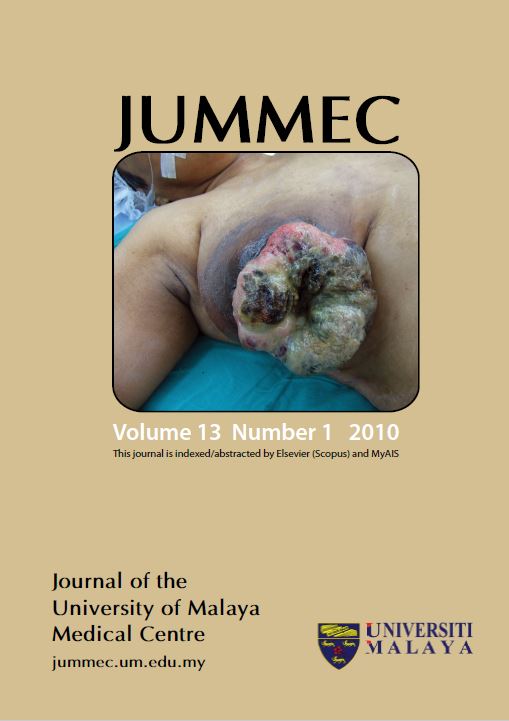PATTERNS OF BREAST CANCER RELAPSE AT UNIVERSITY OF MALAYA MEDICAL CENTRE
Abstract
Despite being the major cause of cancer-related death in Malaysian women, local data on patterns of breast cancer relapse and their long term outcomes are still scarce. We conducted a retrospective study on all patients treated for non-metastatic invasive breast cancer in 1999-2000 at the University of Malaya Medical Centre (UMMC), who subsequently developed relapse.
We sought to analyse the patterns of relapse, their associated clinicopathological features and the overall survival ratefollowing the relapses. Univariate and multivariate analyses were used to analyse demographics and clinicopathological factors. Survival was analysed using the Kaplan and Meier method and compared by the log rank test. A total of 268 patients with a mean age of 50, were identified for the study. At a median follow-up of 50 months, 73 patients (27.2%) had relapsed. Local, regional and distant relapse rates were 5.5%, 1.9% and 19.8% respectively, whereas, the 5-year survival rates were 61%, 40% and 21% respectively (p < 0.01). Most relapses occurred within the first five years of diagnosis. Patients with long disease-free interval had better survival. The most common distant relapse site was the lungs while bone was the distant relapse site with the best prognosis. Disease stage, nodal status and oestrogen receptor status were found to have correlation with the risk of relapse. We concluded that the survival of patients with relapsed breast cancer was associated with the site(s) of first relapse and the disease free interval and clinicopathological factors can be used to predict the risk of relapse.
Downloads
Downloads
Published
Issue
Section
License
All authors agree that the article, if editorially accepted for publication, shall be licensed under the Creative Commons Attribution License 4.0 to allow others to freely access, copy and use research provided the author is correctly attributed, unless otherwise stated. All articles are available online without charge or other barriers to access. However, anyone wishing to reproduce large quantities of an article (250+) should inform the publisher. Any opinion expressed in the articles are those of the authors and do not reflect that of the University of Malaya, 50603 Kuala Lumpur, Malaysia.


